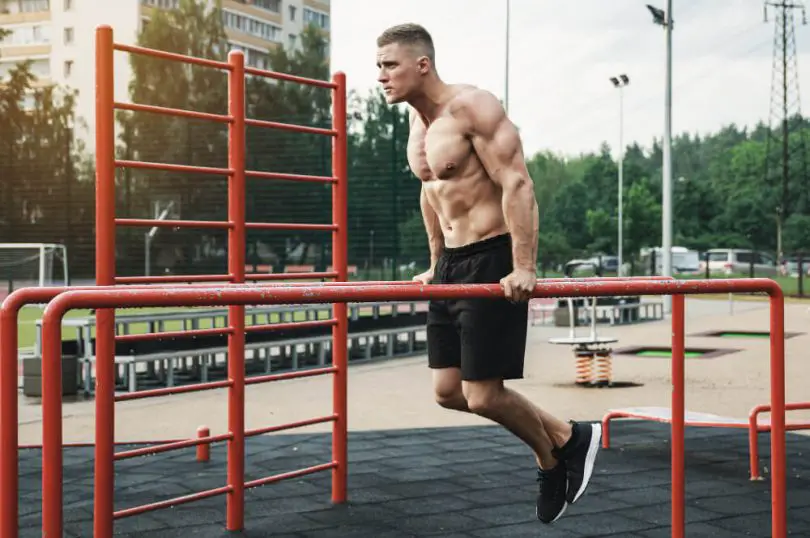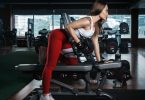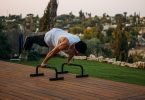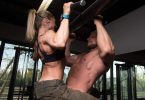Wide vs Narrow Dips – Which is better
Dips are a great muscle-building exercise for the upper body because they allow you to overload your muscles with significantly more weight than you’re used to for an isolation exercise—and often for relatively high reps depending on the level of strength, of course).
What muscles are you building with the dips? And the answer is, it depends on the grip. One targets the chest and the other emphasizes the triceps. So, what’s the difference between wide vs narrow dips. Most people don’t know, so I’ll explain it point by point for you.
Your chest, triceps, and anterior shoulders are the primary muscles targeted by the dip.
Difference Between Wide vs Narrow Dips
Although you cannot really isolate one from the other, you can change the emphasis of the exercise by changing your arm position and torso angle.
Wide grip dips for Chest
-
Wide grip
The wide grip is the most effective grip for the chest. Whether you stand up straight or hunch forward, your chest muscles will be put to the most use. Because the wide grip limits the range of motion at the peak of each rep, wide grip dips aim at the lower and outer chest muscles more than routine width dips.
You should flare your elbows out of your body while lying forward with your torso and keeping your feet behind you when using this grip. Lower yourself until you feel a stretch in your chest, but do not go too far or your shoulders will become overworked.
Narrow grip dips for Triceps
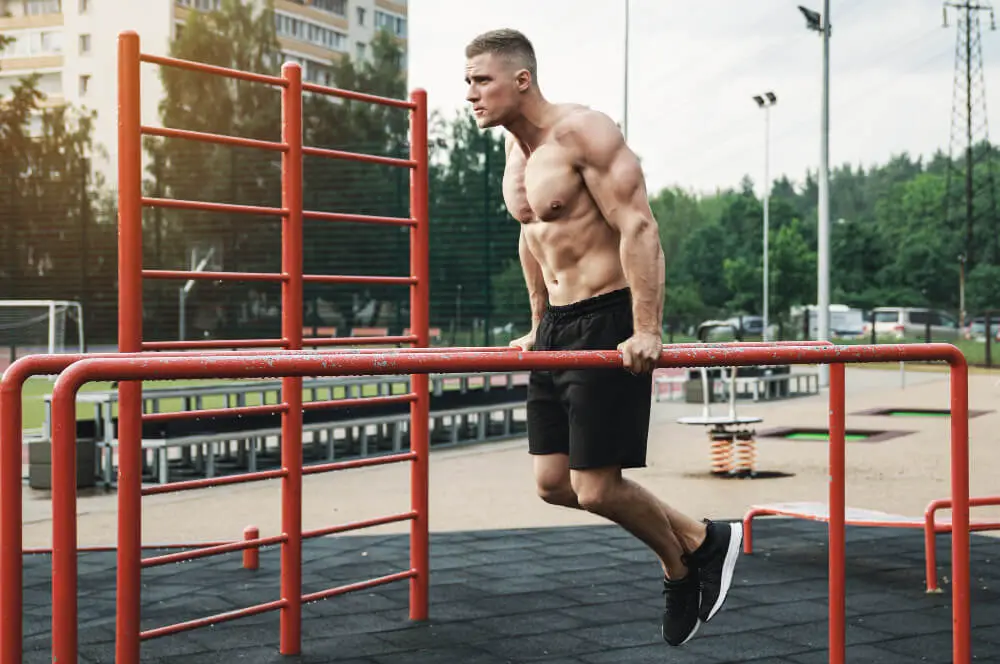
Narrow grip
This is the best grip for triceps work. To stimulate your triceps more, place your feet under your body or partially in front of you, so that your torso is more perfectly straight and your elbow is close to your body.
Dips can be done on either the parallel or single bar. The parallel bars make it much easier to target the triceps because the narrow grip allows you to bend your elbows.
As you lower your body, keep your elbows at your sides and pointing back. This last point is important. Locking elbows — the last few inches of the rep — are all triceps.
Focus on slow, controlled movements while keeping your scapula (shoulder girdle) still.
Benefits of wide vs narrow Dips for upper body
Dip is a combination movement. They necessitate the simultaneous use of multiple joints while forcing your body to stabilize.
They can be done almost anywhere, in addition to stimulating more muscle growth, improving your strength, and potentially enhancing your performance in other lifts. It can also be quite satisfying to lift your entire body weight with just your arms.
If you are trying to lose weight, dips can help you speed up your metabolism by changing your body composition.
Your body expends more energy in order to grow and support your muscles. So, by incorporating muscle to your frame, you are telling your body to break down calories and fat more efficiently, resulting in a leaner, stronger body.
-
Dips can be more effective than bench presses in terms of building chest and triceps.
When you are performing a combination movement that also necessitates you to stabilize your body, more muscle tissue is required to jump into the sport.
The bench you are pressing with your back, and even the floor where your feet are planted, help your body when you do a bench press. When you remove the bench from the equation and begin moving your entire body weight, the intensity of the exercise increases because more muscles are recruited.
Your strength and muscle hypertrophy (muscle-building) gains will improve as you keep increasing your intensity and engage multiple muscles at once. Yes, the intensity of bench pressing can be increased. It won’t, however, target your chest like a dip would. More effective than push-ups
The push-up is the very first exercise that comes to mind when someone asks me to name a bodyweight upper body exercise that works your chest. For a long time, I believed they were the best all-around bodyweight chest builder and arm chisel exercise.
Your arms are primarily supporting the weight of your upper body in the push-up position.
During a dip, however, you are only using your arms to support your entire body weight. Because you do not have the extra stability support of keeping your feet on the floor like you do during push-ups, your core comes in handy to keep you from swinging.
Dips, in general, provide more bang for your buck in terms of chest and triceps development.
-
They Are Functional Exercises
Functional exercises can help you improve your movement patterns and improve your quality of life by reducing aches and pains that occur during daily activities. While resistance training is great for building strength and changing your body composition, it can sometimes leave you deficient in your smaller muscles.
Bodyweight and operational exercises teach your muscles to work together more effectively, resulting in improved movements and a lower risk of trying to twist something because the right muscles are trained or clearly aimed.
Heavy lifts with external weights can lead to compensation if you are not paying attention, and bodyweight workouts often promote a greater range of motion and protect your overall health.
-
Tangible Progress
Whether you have managed to master the dip or are just learning how to do it, it is a workout that lends itself to very accurate progression measurements.
It is comprehensible that not being able to hold your body weight in a consistent manner, let alone attempting to reduce and feeling pain, can be frustrating when you are first starting out. Which means your body is warning you that if you do not stop, you might die.
-
Improve pushing strength
One of the most basic movement patterns is pushing. These are the movements you perform in your daily life to help you perform tasks like squatting down to pick up a piece of steel and then simply pushing it in the air.
Doing dips, on the other hand, can make you healthier by contributing to your overall strength, in addition to helping you in your daily life.
This translates into making your lifts such as bench presses, push-ups and overhead presses when you strengthen your ability to push in different positions.
-
Target Your Chest
While bench pressing is a popular choice for chest day, dips should be included in your routine as well. When it comes to chest development, the angle of your chest during the dip helps you in a couple of ways.
You also get the additional advantage of involving a bit more essence in the movement, which helps your body build more anabolic, or muscle, signals to spur growth.
Lifting heavy during the bench press makes a lot of sense because it promotes muscle growth. Although calisthenics exercises are superior in terms of preventing injury, it is a slightly more effective way to target your chest without the risks of pushing yourself to heavyweights that may necessitate the assistance of a spotter.
A spotter is not required for dips. These can be done anywhere. And if they are programmed and executed correctly, you will definitely notice them and see results.
-
Stabilization
During all activities, your core is predominantly responsible for sustaining and protecting your spine. It is made up of a group of muscles in the front, sides, and back of your torso that all work together to help you exercise properly.
Because you are basically hanging in the air while diving, you will need a lot of stabilization to keep your body from moving all over the place. You may miss out on training your smaller, helpful stabilizer muscles if you only do exercises where your body is supported by the floor, a bench, or a machine.
These muscles provide numerous advantages in terms of building a stronger and more defined body, as well as being the source of much of your power. As a result, the more stable your core is, the stronger it is, and the stronger you are as a whole.
-
Wide Chest
As you keep increasing the stretch at the bottom of the movement, you will be able to achieve better contractions by activating more muscle fibers. The effectiveness of the workout will increase as muscle fiber activation increases, providing more stimulation for your chest to build muscle.
While it may be difficult to isolate your outer chest, a higher muscle-building stimulus delivered with increased intensity will eventually contribute to overall chest development, giving you the appearance of a wider chest.
-
Improve Your Bench Press
Dips can help you build your pushing strength, which can help you increase your bench press.
Avoid these mistakes when doing wide vs narrow dips:
No swinging or bouncing – if the move isn’t perfectly smooth, you’re doing it wrong. If this is too difficult for you, reduce the range of motion until you get a little stronger.
Don’t lock the elbows on top – pause a bit before full lock.
Dips at home
A dip does not necessitate the use of a gym. There are numerous tools available online or in your home that can assist you with your dips.
- Dip Stand
- Suspension Strap (like the popular TRX)
- A playground near your house
- Stools/chairs
- Kitchen counter
As you improve at the exercise, you will want to increase the weight to keep your muscles challenged as they adapt, so you do not plateau and lose progress.
Should I Do Weighted Dips?
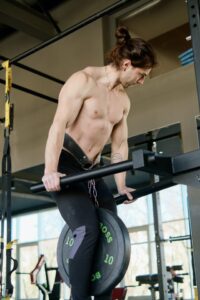
Weighted dips are a great way to keep progressing by adding some external resistance. However, before adding weight to the exercise, it is important to master a few bodyweight dips and be able to maintain proper form. This will assist you in avoiding injuries as well as muscle imbalances.

